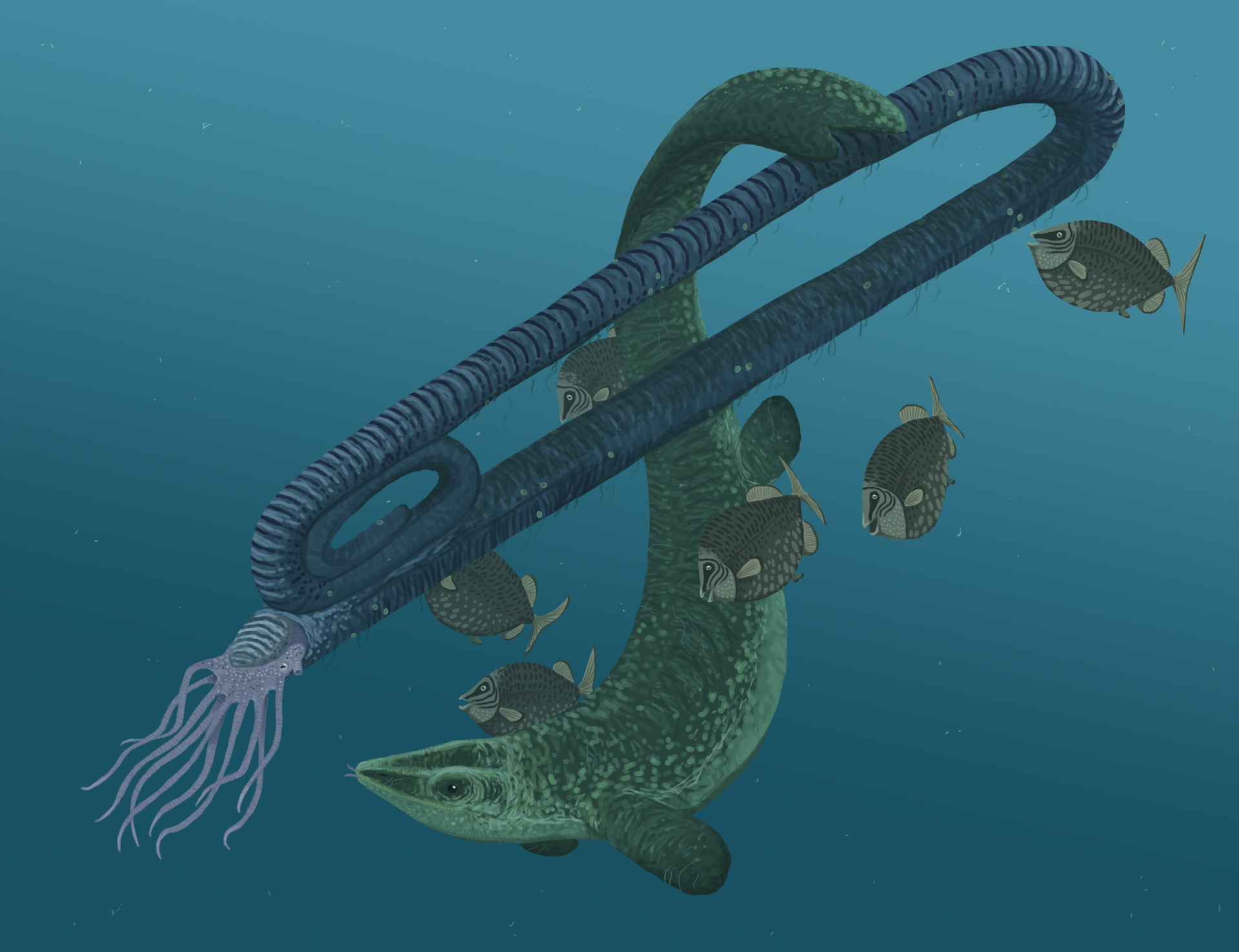HOME | DD
 TrollMans — Enigma of the Sea Trombone
TrollMans — Enigma of the Sea Trombone

Published: 2019-02-03 07:17:19 +0000 UTC; Views: 31839; Favourites: 613; Downloads: 57
Redirect to original
Description
Patrolling along the edge of the continental shelf for the mollusc prey he relishes, a Carinodens picks up the scent of a potential meal in the water nearby. However, he discovers not the familiar sight of a coiled or bivalved shell, but a strange aberration as large as he is. It smells like prey, but looks like some non-euclidean, semi-corporeal polyp being, the mere existence of which spits at the constructed laws of tangible reality.Is something so bizarre even edible? He doesn't know.
---
Late Maastrichtian (66 MYA), Netherlands
Diplomoceras cylindraceum (cylinder-like diploma(?) horn)- a species of heteromorph ammonite known from the Late Campanian to Maastrichtian of shallow seas worldwide. Like many heteromorphic ammonites, its shell was unwound, and in this case, extremely elongated; individuals of the species could be over two metres in shell length (over four metres if measured from the tip of the coil to the head end). The shape grew into the paperclip-like form as the animal matured, and the youngest ammonites were straight-shelled. As with most heteromorph ammonites, it is unknown what the purpose of such a shape was for, although it probably was not hydrodynamic, which may indicate a primarily benthic existence. Despite the strange shape of the shell, fossils indicate the species was extremely successful, being relatively long lived and known from hundreds of fossils (which may suggest, that like many cephalopods, it lived in shoals) on every continent. Fossils of similarly shaped close relatives imply however strange the shape was, it was a winner.
Carinodens belgicus (Belgic keeled teeth)- a species of mosasaur known from the Maastrichtian of Eastern Europe and Morocco. This is one of the smallest known species of mosasaurs, reaching only around three metres in length. A close relative and sister taxon to the larger Globidens, and similar to its relative, was probably durophagous. Its back teeth were rounded and blunt, suggesting that they were used to crush hard-shelled prey like crustaceans, ammonites, bivalves, and nautiloids, which were common in the environments it is known from. It had heterodont dentition, as the front teeth were thinner and pointier, probably being used to snag prey before bringing the food item to the back teeth for mastication. Its fossils are relatively uncommon in the Maastricht Formation despite the abundance of potential prey, possibly suggesting that its preferred habitat were away from the shallows, where its far more massive relatives would have patrolled.
- some pycnodonts (Anomoeodus subclavatus) and their limpet prey; appearance is speculative as the species is known only from teeth.
---
Ah, heteromorph ammonoids, truly the strangest animals that have existed on Earth. And not just because we really have no idea how they even existed, but because they weren't just some sort of evolutionary dead-end one-off. Oh no, they were very successful; fossils of Diplomoceras cylindraceum indicate it lasted at least five million years and was widespread, with fossils known from all seven continents, lasting until the very end of the Maastrichtian, and this "paperclip" design was present in many other related species for millions of years prior as well.
And we also got heteromorph ammonites that look like soft-serve ice cream covered in spikes, jumbled up slinkies, spiny saxophones, just poles, and other shapes that are really indescribable. And of course in life, there would have been tentacles sticking out of one end. Their massive success despite looking like something that should have been abandoned back in the Cambrian defies reasonable human explanation. Some deity (or more likely, all deities in an overwhelming vote) must have sent that asteroid because they were getting too powerful.
Related content
Comments: 31

👍: 1 ⏩: 0

👍: 0 ⏩: 0

👍: 0 ⏩: 0

👍: 1 ⏩: 0

👍: 0 ⏩: 0

👍: 6 ⏩: 1

👍: 1 ⏩: 0

"It looks like you're trying to decide whether you want to eat me or not.
Would you like help with that?"
👍: 4 ⏩: 0

👍: 0 ⏩: 0

Very interesting form of self-defense...not poison, not fight or flight, just looking highly strange. Far too strange for any predator to want to eat, maybe consider eating...but most likely question "the heck is this?" only for them to move on and find something more familiar of a meal.
Very good work, not that you needed to hear it from me!
👍: 1 ⏩: 1

👍: 2 ⏩: 0

At first I thought it was a giant paperclip O.o
By the way, I think that strange animal could actually be a petrified snakeskin shed that has been misinterpreted as some kind of ammonite.
Or is actually a paperclip or some kind of metal.
👍: 0 ⏩: 0

Ok i’m Just confused..what kind of evolutionary advancement is that shell gonna do?!
👍: 1 ⏩: 0

Funny, your description has read my mind, I thought it's shell looked more like a paperclip than a trombone.
👍: 0 ⏩: 0

imagine playing the sea trombone instead of the land trombone
👍: 0 ⏩: 0

SEA TROMBONE: "Ugh, another straight-line sea lizard, how VANILLA."
👍: 0 ⏩: 0

Fascinating ammonite. I love creatures that look really odd and unusual.
👍: 0 ⏩: 0

Cthulhu needed some paperclips for all the paperwork governing his empire and boom
👍: 1 ⏩: 0

Very nice work and good to see some people making art of the less often depicted fauna of the Maastricht formation.
I'm working on a big project involving all biota of the Maastricht formation and I wonder if I can use this artwork (with credit of course) in my presentation and/or highschool paper.
👍: 0 ⏩: 1

That's sounds fine, just remember the credit.
👍: 0 ⏩: 1

I want some of what god was smoking when he came up with these designs XD
👍: 0 ⏩: 0

































